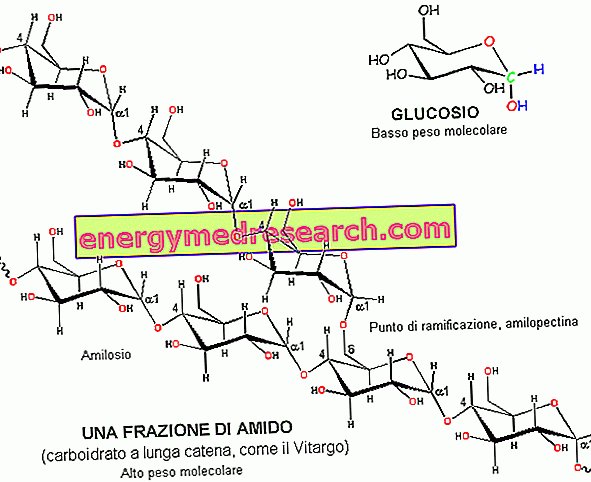See also: vitargo supplements
Vitargo is the registered name of an exclusive polysaccharide, studied and patented at the Karolinska Institute in Stockholm (Sweden). Basically, it is an energy supplement with superior characteristics, which elevate it compared to other products available on the market. Like all supplements belonging to this category, Vitargo is obtained from the processing of starch, a polysaccharide (complex carbohydrate) typical of the vegetable kingdom (usually extracted from corn or potatoes). This precious nutrient consists of a long series of glucose molecules, which form linear and branched chains. During industrial processing, starch is subjected to hydrolysis, that is to a process that breaks it down into glucose chains of varying length. The molecular weight of these polymers is the higher the greater the complexity of the glucidic chains that constitute them, and vice versa.

| Carbohydrate | Molecular weight |
| Starch | > 250, 000, 000 |
| Vitargo | 500, 000 - 700, 000 |
| Maltodextrin | 1, 000 - 1.0000 |
| Starch syrup | 250 - 1, 000 |
| Dextrose (glucose) | 180 |
As shown in the table, the Vitargo is distinguished from other supplements by its high molecular weight, which indicates the complexity of the carbohydrate chain that constitutes it. Another parameter that quantifies this characteristic is the so-called dextrose equivalence (DE); the lower this value is, the greater the complexity of the carbohydrate carbohydrate chain is.
Therefore, the Vitargo is distinguished from other energy supplements by a higher molecular weight and lower dextrose equivalence.
All these features give Vitargo interesting nutritional properties. Among these, the most interesting and publicized regards the intestinal absorption of carbohydrate. Let us briefly recall that osmosis represents the passage of the solvent - through a semipermeable membrane - from the compartment in which the solutes are more diluted to that in which they are more concentrated. If we take a common Energy drink, the solvent is water and the solutes the carbohydrates dissolved in it.
Osmolarity expresses the concentration of a solution, emphasizing the number of particles dissolved in it (regardless of electric charge and size). The osmolarity of a solution increases as the number of particles it contains increases; consequently, a glucose-based drink has a higher osmolarity than its Vitargo-based counterpart. The addition of electrolytes (mineral salts) as well as artificial preservatives and sweeteners also increases the osmolarity of the solution.
Under normal conditions the osmolarity of the plasma i is between 280 and 330mOsm / kg. Similar values are found in so-called isotonic drinks, higher values in hypertonic and lower values in hypotonic ones.
Once ingested, hypertonic beverages (very concentrated, therefore with high osmolarity), due to the aforementioned laws of osmosis, recall liquids in the stomach (delaying emptying) and in the intestinal lumen, aggravating dehydration and becoming a source of possible intestinal disorders ( diarrhea). The reverse phenomenon is instead typical of hypotonic drinks, such as those based on vitargo, ideal for rapid absorption at the end of an effort.
| Type of drink | Content | Indications |
| hypotonic | Fluids, electrolytes and a bass carbohydrate content | Rapid rehydration, but little energy |
| Isotonic | Fluids, electrolytes and a 6 - 8% carbohydrate | Rapid rehydration and energy |
| hypertonic | High carbohydrate content | Poor and slow rehydration, but high energy |
The last parameter to consider to understand the properties of Vitargo is the glycemic index. As is known, at most this value represents the speed with which your blood sugar rises in carbohydrates. The simpler their structure is and the higher the glycemic index is, and vice versa. The Vitargo, therefore, in theory should have a lower glycemic index than the other carbohydrates contained in energy supplements. The reason for this relationship lies in the greater digestion time needed to break down its long chains, which would guarantee a constant flow of glucose, preventing excessive glycemic and insulin spikes. Despite the theoretical premises, on its website the company communicates that, although there are no specific data, the values of glucose and insulin recorded after taking vitargo leave a higher glycemic index than maltodextrins, equal to about 137 (value obviously calculated by taking as a reference to 100 the glycemic index of white bread, according to which glucose shows a glycemic index equal to 140, consequently the vitargo would have a glycemic index similar to that of pure glucose). Evidently the structure of the vitargo is more branched than that of maltodextrins, which facilitates the action of amylases by exposing to their action a greater specific surface of the carbohydrate.
All these characteristics justify the great effectiveness of Vitargo in restoring the muscular and hepatic reserves of glycogen after an intense physical effort. In several studies, this property has proven to be far superior to that of other common carbohydrate supplements. The first to benefit from this interesting property are, for obvious reasons, endurance athletes (cyclists, marathon runners, cross-country skiers, triathletes etc.). Even bodybuilders can take advantage of Vitargo's properties to increase their muscle mass, thanks to a better recovery from the most demanding sessions and a better glycogen saturation in the carbohydrate refill phases.
The only neo of the Vitargo, being covered by a patent, is the cost considerably higher than the other energy supplements.



